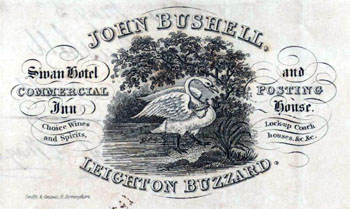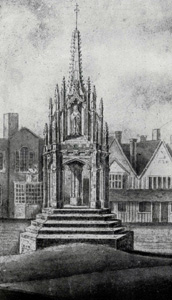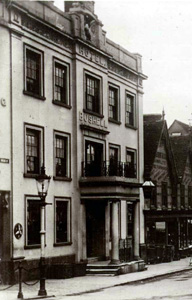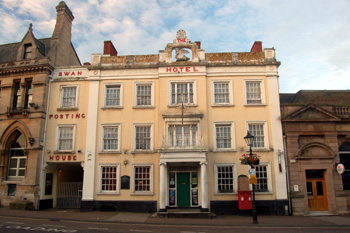The Swan Hotel Leighton Buzzard

Swan billhead 1836
The Swan Hotel: 50 High Street, Leighton Buzzard [earlier the White Swan Inn]
The Swan Hotel dominates the northern half of the High Street. It was listed by the former Department of Environment in 1975 as Grade II, of special interest. It dates from the early to mid 19th century but there has been a Swan in Leighton Buzzard for much longer. The first reference to it is 1600 when Edward Carvell devised it to his wife Elizabeth, remainder to their daughter Joan [ABP/W1600/8]. Joan married John Osmond and in successive ledgers for the Manor of Leighton Buzzard alias Grovebury in 1621 [KK775], 1626 [KK776] and 1627 [KK777] he is shown as paying a quitrent of two shillings and seven pence for the Swan, showing that it was a freehold property. In 1653 Richard Osmond sold the Swan to London vintner Samuel Turner [SX116] who paid the quitrents in 1656 [KK780] and 1664 [KK781]. He conveyed "a capital messuage with a little tenement attached called the Swan Inn" to Robert Stone of London in 1674 [WI1].
Markets attracted farmers and traders from many miles around. They also attracted criminals and Leighton Buzzard, as an important local market attracted its fair share of the latter as assizes rolls from the mid and late 17th century show. It is not surprising, then, that inns are frequently mentioned in these, as that is where most of the business was done, in specially set aside market rooms. One of the most frequent crimes was to steal livestock and drive it to market for a quick sale. In December 1677 one such incident occurred at the Swan, the following being the statement of the innocent party in a shady transaction [note the archaic spellings]: "The Informacon of Lawrence Cripps of Ridgmont in the county aforesaid Butcher taken the Tenth daie of December Anno Domini 1677: This Informant sayeth that on Tuesdaie beinge the fourth of this Instant December hee beinge att Leighton Markett bought three Steares vidzt too black ons and one Brindled one of one Joseph Warner now prisoner in the comon Gaole att Bedford for Twelve pounds and a leaven shillings And that the said Joseph Warner told him hee brought them from Mogerhanger from the widdow Powers and that hee was implyed by her for to sell them. But hee [Cripps] saieth hee was about buying the said Steares in the Markett and that there was about foure shillings betwixt them. And that hee was about the space of one houre in bargaineinge for them after hee came within the said price. And hee further saieth that the said Steares was turned into the Inn yard beinge the Signe of the Swan. And within the said house hee bargained for them and there hee paid the said Joseph Warner eight pounds and one shillinge and that the said Steares stod in the Markett about three houres as hee supposeth before hee bought them. And hee allsoe sayeth that hee was goeinge to send for the Toleman but hee cam in in the meane time of his owne accord and there upon examinacon of the partie as sold them apprehended him upon suspition of stealeinge them. But the said partie as sold the said steares went under the name of Joseph Minor as hee supposeth and the Rest of the money was to bee paid as on Tuesday next beinge the next Markett daie And further sayeth not". [HSA1678/W/63].
The importance of the Swan at this time is attested to by documents naming it as the location for a meeting to repay mortgage monies [NC414 of 1678 and NC415 of 1682]. In 1712 Robert Stone devised the Swan in his will to his brother John. Three years later John devised the inn, then called the White Swan, to his son James [X172/5], the will being proved in 1716. James sold the inn to John Ashwell in 1723 [X172/6-7] and five years later Ashwell devised it to his youngest son Thomas [X172/8]. In 1748 a proposed auction sale was to be held at the Swan [BO673], this would become an increasingly profitable enterprise for the inn during the next two centuries. Robert Ashwell paid the two shillings seven pence quitrent for the Swan in 1749 [KK783] whereas it was Edward Ashwell, a nephew of John Ashwell, who paid in 1772 [KK785]. He conveyed it to a draper, John Cox, in 1787 [X172/9-10].
In 1960 Bedfordshire Historical Records Society published a volume, its fortieth, dedicated to diaries. County Archivist Joyce Godber edited and published the diary of Leighton Buzzard Justice of the Peace John Salusbury (1713-1787) written between the years 1757 and 1759. He frequently mentions the Swan, firstly on 5th September 1757 when he "drank a bottle" with four others. On 9th September: "Between 7 and 8 in the evening Mr. Birt called on me and I went with him to the Swan and spent the rest of the evening with him there". He met four others there on 20th September, whether for business or pleasure he does not relate. He visited the Swan more frequently than any other hostelry in the town, a sure sign of its relative importance even at this date. Just before Christmas, on 22nd December, he "went for about an hour to the Swan and Captain Hutton and spent sixpence there".
His next visit was on 31st January 1758 when he spent half a crown there in company. On 7th March he was again there with friends and on 23rd was there with his club, the Civil Society as he was on 18th May. On 31st May a prebendal visitation was held at the Swan, this was when the Prebend of Leighton Buzzard or, more usually, one of his officers such as the Registrar, checked on the business of the Peculiar. On 27th June he "went to the Swan with Captain Hutton, where I stayed about an hour and a half and then went to Mr. Ward's". A meeting of the Commissioners of the Window Tax was held there in August 1758. On 18th September he simply noted "dancing at the Swan this evening". He was again there with company on 21st November and on 7th December when the Civil Society were there.
His first visit of 1759 was on 6th January when "Captain Hutton and his company [of the Bedfordshire Militia] dined at the Swan". On 2nd March he "went to the Swan, where had been a sportsman's dinner". On 22nd May: "In the afternoon went to the Swan, to Captain Jenkins, Mr. Gough and Franklin, where we quaffed a bottle of port a man and upwards, and the Captain treated". One hopes they were small bottles. On 4th June "Captain Hutton, Messrs. Gough, Ward, Deverell, Walker and I met at the Swan to drink the Prince of Wales' health…did not break up till past twelve". The Prince of Wales would become King George III the next year, 4th June 1759 was his twenty first birthday. On 15th June he dropped in to the Swan with friends on his way to see The Recruiting Officer, a play written in 1706 by George Farquhar. On 10th July he dined at the Swan with the Commissioners of the Land and Window Tax. On 22nd August he "drank tea at Mr. Ward's and then went to Captain Hutton and Mr. Charnock at the great house, from whence we adjourned to the Swan and spent a shilling apiece".
On 27th September Salusbury "dined at the Swan with Mr. Charnock, Gough, Ashwell, Davies, Captain Hutton, Dr. Pettengall, Moreton, his brother-in-law and one Mr. Lawford, being a previous meeting for the establishing a monthly club". On 10th October he "dined at the Swan, being the day of our monthly club meeting". The final mention of the Swan in his diary was on 2nd November: "Made Mr. Charnock a morning's visit and went with him to the Swan, it being our monthly club day".
In the Northampton Mercury of 19th January 1793 licensee of the Swan, Thomas Marriott, subscribed to a resolution of Leighton Buzzard publicans banning "seditious and disaffected persons" from their houses. This presumably was in reaction to the events across the Channel in France (four days previously King Louis XVI had been sentenced to death and two days later he went to the guillotine). Three years later Marriott bought the inn from John Cox [X172/14]. The sale did not include the little tenement mentioned in 1674 which was described as a cottage being the east part of the inn in occupation of John Laurie (the gateway of the inn being west and a messuage of Peter Basset east "fronting north into the market place there against the cross"). It comprised the "shop in front next the gateway, the parlour behind the same, the kitchen or sitting room adjoining, the passage to the shop, brewhouse adjoining the Swan brewhouse, two chambers in front on the first floor, two chambers in front on the second floor and garrets over them, two chambers over the kitchen, two chambers over the brewhouse and three cellars under the shop and parlour" - presumably this stood on the site of today's 52 High Street.

The Swan about 1810
Thomas Marriott did not own the inn long, selling it in 1800 to James Oliver, late of Dunstable, now Leighton Buzzard, innholder [WI11-12]; Oliver conveyed the inn to John Bushell, late of Coventry, now Leighton Buzzard, innholder in 1805 [WI14-15]. The billhead at the top of the page dates to 5th May 1834 [P91/25/33] - it was itemised as follows:
- Lunch's Ale & co. 2/10
- Old Ladys Eating & Ale 6/-
- Gin to Ditto 1/6
- Ale Porter Wine & co 2/6;
- 9 gents Dinners £1/16/-
- Ale & Porter 4/3
- Wine £2
- Old Ladys Catring & Ale £1/1/10
- Roles to Boys £1/12/-
- Ale to Ditto £1/10/-
- Fires 2/-
- Servants 5/-
Total £9/3/11At the time of the countywide Register of Licensed Premises of 1876 the owner was Mary Bushell. By the time of the countywide Register of Licensed Premises of 1891, however, the owner was William Green Towers of Leighton Buzzard.

Swan Hotel about 1885 [Z1130/72]
In 1952, in Volume III of the Bedfordshire Magazine, Page Woodcock described the interior of the Swan thus (page 195): "The bar once had pew seats; now it has boxed beams and basket chairs. The 'snug' is the bar for the regulars. Its walls are appropriately decorated, for what could be more fitting for merry men that the Laughing Cavalier flanked by Hogarth's Beer Land and Gin Lane? The yard once had stabling for forty horses; garden, piggery, henhouse, garages and stabling for six horses remain. But the market-town atmosphere still pervades the inn. In today's dining-room is installed modern hot-plate equipment, but the surroundings are as Georgian as ever they were. And the tail coated waiter, the comely smiling waitress, the roast beef and Yorkshire, all seemed well in keeping. Our visit to the kitchens was almost Dickensian. The Swan has no staff troubles, a good sign of happy management. We met 'Cookie', Mrs. Emily Jones ('No Cookie, no Swan' said the Major), bearing lightly her twenty-three years as hotel chef. We imbibed together, bless her!" In the article the writer goes on to note the visitor's book, including General Sir Horace Smith-Dorrien just before World War One (he was commander-in-chief of Second Corps, which fought the Germans at Mons and la Cateau-Cambrésis in 1914 who also served in the Zulu War of 1879 and escaped from the massacre at Isandlwana - he lived not far away in Berkhamsted [Hertfordshire]).
In 1956 alteration were made to the entrance from hall to the cocktail and gentlemen's bars. There was a fire at the hotel in 1967 [FSD/PC5] and later alterations included: erection of a conservatory in 1984 and its extension in 1985; rebuilding of the chimneys in 1986; division of the ballroom into first and second floor bedrooms in 1991 and demolition of a rear store in 1992. The Leighton Buzzard Observer of 1st September 2009 announced that the Swan has closed for business and was on the market for a buyer who would renovate it. The building was bought by the pub chain J D Wetherspoon Plc and renovation began in March 2011 with an intended opening date of July that year.

The Swan June 2008
References:
- ABP/W1600/8: will of Edward Carvell: 1600;
- KK775: Manor of Leighton Buzzard quit rental: 1621;
- KK776: Manor of Leighton Buzzard quit rental: 1626;
- KK777: Manor of Leighton Buzzard quit rental: 1627;
- SX116: covenant to levy a fine: 1653;
- KK780: Manor of Leighton Buzzard quit rental: 1656
- KK781: Manor of Leighton Buzzard quit rental: 1664;
- WI1: conveyance: 1674;
- HSA1678/W/63: stolen cattle sold in Swan yard: 1677;
- NC414: location for repayment: 1678;
- NC415: location for repayment: 1682;
- X172/4: devise: 1712;
- WI3 and X172/5: devise: 1716;
- X172/6-7 and WI2-3: covenant to levy a fine: 1723;
- X172/8: devise: 1728;
- BO673: proposed auction sale at Swan: c.1748;
- KK783: Manor of Leighton Buzzard quit rental: 1749;
- X171/190: auction sale held at Swan: 1769;
- KK785: Manor of Leighton Buzzard quit rental: 1772;
- X172/9-10 and WI4-5: conveyance: 1787;
- KK432-433: auction sale held at Swan: 1790;
- Northampton Mercury: resolution of Leighton Buzzard publicans banning "seditious and disaffected persons" from their houses: 19 Jan 1793;
- X172/14 and WI6-7: deed to lead to the uses of a fine: 1796;
- WI11-12: release: 1800;
- WI14-15: conveyance: 1805;
- CLP13: Register of alehouse licences: 1822-1828;
- P91/25/33: John Bushell billhead: 1834;
- BO1453: auction sale held at Swan: 1844;
- BO1547-1555: Inclosure Commissioners meetings at Swan: 1846;
- BO1636: Inclosure Commissioners meetings at Swan: 1846;
- BO704: memorandum of Grand Junction Canal meeting at Swan: 1847;
- PSLB4/1: Register of Alehouse Licences - Leighton Buzzard Petty Sessional Division: c.1860s-1949;
- PSLB4/3: Register of Alehouse Licences - Leighton Buzzard Petty Sessional Division: c.1860s-1956
- Z210/81: draft composition agreement: 1873;
- BML10/42/40-42: auction sales held at Swan: 1875;
- BML10/23/4: auction sale held at Swan: 1888;
- BML10/30/12: auction sale held at Swan: 1888;
- BML10/42/82-83: auction sales held at Swan: 1888;
- GA2584-2585: auction sales held at Swan: 1888;
- BML10/44/25: auction sale held at Swan: 1889;
- BML2/2/38: detailed valuation of Swan: 1893;
- X95/313-314 and WB/S4/1/1/5: sale catalogues of T. Sworder & Company brewery and licensed premises: 1897;
- HN1/20-1-3: position shown on annotated Ordnance Survey maps compiled for licensing purposes: early 20th century;
- Z210/7: auction sale held at Swan: 1902;
- BML10/42/129: auction sale held at Swan: 1907;
- BML10/42/142-143: auction sales held at Swan: 1911;
- BML10/42/367: auction sale held at Swan: 1911;
- BML10/42/144: auction sale held at Swan: 1912;
- BML10/44/42: auction sale held at Swan: 1912;
- BML10/42/146-150: auction sales held at Swan: 1913;
- BML10/42/152-153: auction sales held at Swan: 1914;
- BML6/11/11: auction sale held at Swan: 1915;
- BML10/22/42: auction sale held at Swan: 1916;
- BML10/42/154-155: auction sale held at Swan: 1916;
- BML10/72/5: auction sale held at Swan: 1916;
- BML10/42/157: auction sale held at Swan: 1917;
- BML10/30/50: auction sale held at Swan: 1918;
- BML10/42/158: auction sale held at Swan: 1918;
- BML10/42/161: auction sale held at Swan: 1918;
- BML10/42/162: auction sale held at Swan 1919;
- PSLB4/2: Register of Alehouse Licences - Leighton Buzzard Petty Sessional Division: 1922-1948;
- BML10/42/178: auction sale held at Swan: 1930;
- BML10/31/11: auction sale held at Swan: 1931;
- BML10/42/180: auction sale held at Swan: 1931;
- BML10/42/421: correspondence regarding Fat Stock Show Christmas Dinner: 1937-1938;
- BML10/72/6: auction sale held at Swan: 1938;
- BML10/44/63: auction sale held at Swan: 1938;
- BML10/44/64-65: auction sales held at Swan: 1939;
- BML10/42/219: auction sale held at Swan: 1939;
- BMl10/44/77: auction sale held at Swan: 1946;
- BML10/44/79: auction sale held at Swan: 1946;
- BML10/42/240-242: auction sales held at Swan: 1946;
- BML10/44/80: auction sale held at Swan: 1946;
- BML10/42/243: auction sale held at Swan: 1947;
- BML10/42/246-247: auction sale held at Swan: 1948;
- BML10/42/250: auction sale held at Swan: 1948;
- BML10/44/81-82: auction sales held at Swan: 1949;
- BML10/42/253-254: auction sale held at Swan: 1949;
- BML10/42/256: auction sale held at Swan: 1949;
- BML10/42/258: auction sale held at Swan: 1950;
- BML10/44/83: auction sale held at Swan: 1950;
- BML10/67/50: auction sale held at Swan: 1951;
- BML10/42/259-260: auction sales held at Swan: 1951;
- BML10/42/261: auction sale held at Swan: 1952;
- BML10/42/264: auction sale held at Swan: 1953;
- BML10/42/269: auction sale held at Swan: 1957;
- BML10/30/74: auction sale held at Swan: 1958;
- BML10/42/274: auction sale held at Swan: 1960;
- BML10/42/275: auction sale held at Swan: 1961;
- FSD/PC5: newspaper report, with photographs, of fire at hotel: 1967
List of Licensees: note that this is not a complete list; entries in italics refer to licensees where either beginning or end, or both, dates are not known:
1653: Richard Osmond;
1715: Elizabeth Morley;
1723-1728: Edward Walker;
1785-1787: William Jackson;
1793-1796: Thomas Marriott;
1811-1834: John Bushel;
1839: Mary and John Bushel;
1841: Mary Bushell;
1847: Margaret Bushell;
1851: Mary Bushell;
1853-1854: John Bushell
1861-1884: Mrs Mary Bushell [convicted of keeping open after closing hours, date not specified, fined £5 with 8/- costs];
1884-1893: William Green Towers;
1893-1924: Catherine Lowers;
1924-1928: Frederick Arthur Birks;
1928-1943: Arthur Herbert Relf [3 Feb 1932 Supper Hour Certificate granted];
1943: Aubrey Garrett Flavell;
1943-1947: Hannah Mary Sybil Jeffreys Morgan;
1947: Richard Arthur Warry;
1947-1953: Frederick William C. Woods;
1953: William Edward Flynn;
1953-1954: Philip McGregor;
1954-1956: William Reid Fraser;
1956: Richard Michael Fisher;
1965: Roy Shrubshall;
1966: Brian Ivor Clifton “representing Mr. Mann”;
1966: Frederick David Harding;
1967: Brian Ivor Clifton and Frederick Harding;
1968: Charles René Diacono and Frederick David Harding;
1968: David Richard Charles Ferguson and Frederick David Harding;
1969: Lawrence Stoney;
1970: Lawrence Stoney and Martin Fever;
1970: Martin Fever and William John Britton;
1971: Paul Vyvyan Douglas Horne and Ian Jackson Bews;
1974: Christopher Ashford Knight;
1976: Antonio Marco Gerardo Danielli;
1977: Geoffrey Ernest Mountford;
1977: Athol Bruce Burke and Patrick Arthur Burke;
1979: Audrey Virginia Minards;
1980: Jane Felicity Stephens;
1991: Anthony Paul Maxwell and John Baptist Garvey;
1993: Duncan Entwistle;
1993: Duncan Entwistle and John Baptist Garvey;
2000: Sheila Noble